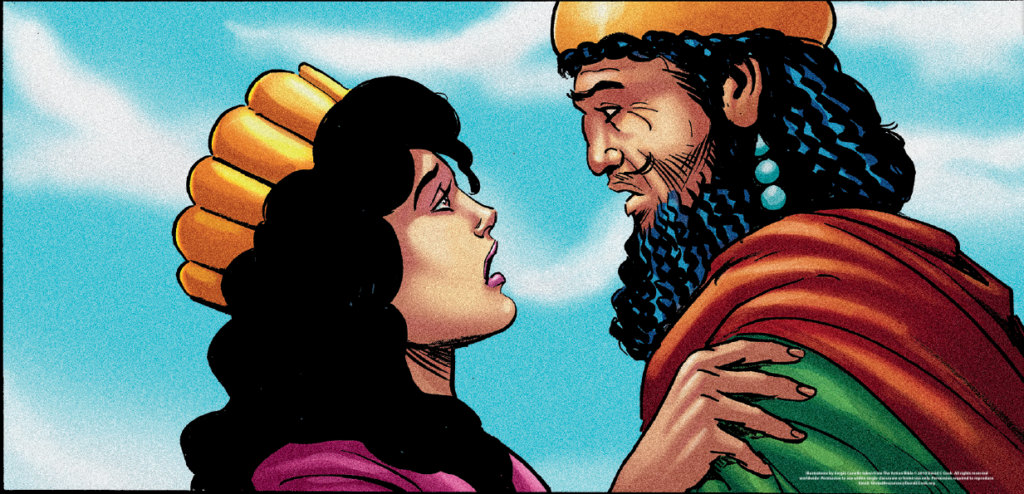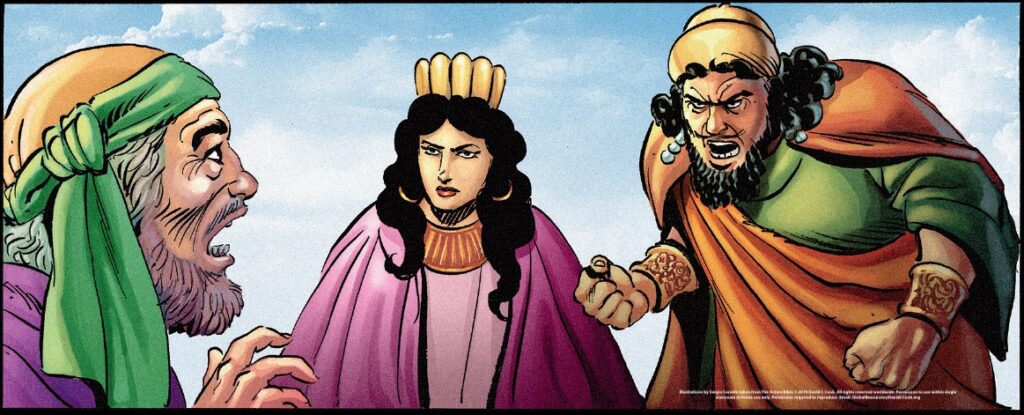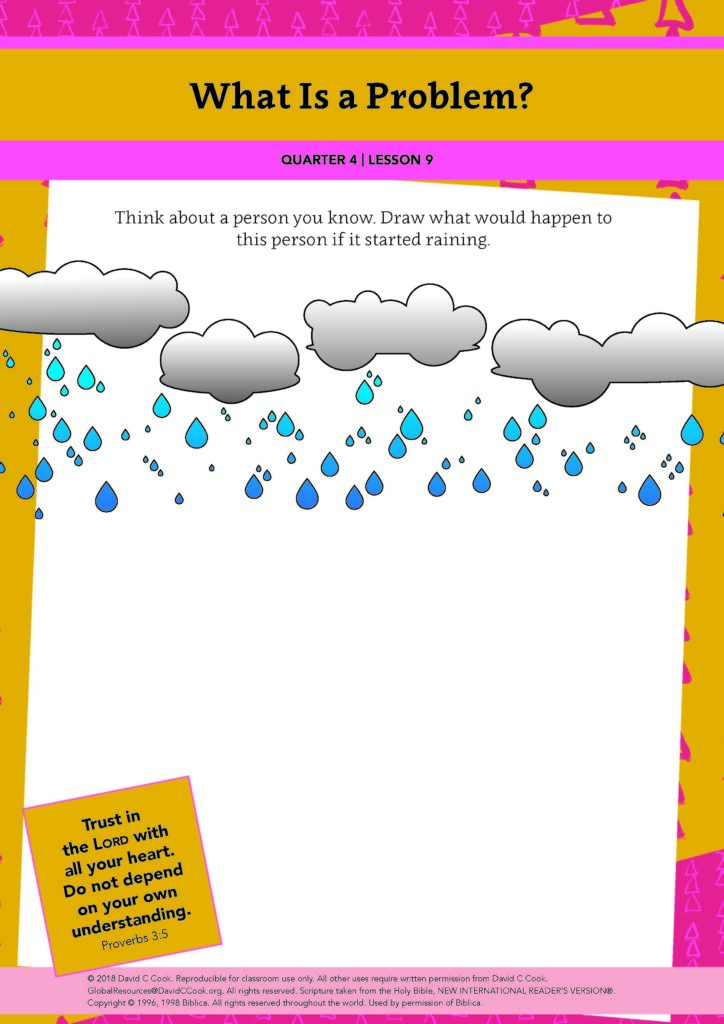During the lesson, the information for you to know is written in regular type, and what we suggest speaking or reading aloud to children is in bold. All resources for this lesson, including the Teacher Guide, Student Page, Family Connection Card, and other resources can be downloaded in a ZIP file by clicking on the following link:
In some lessons you will find "resource articles." These are articles written by experts from around the world to help equip you for your work with children and adolescents. Share them with parents or guardians if you consider it appropriate.
Trust in the Lord with all your heart. Do not depend on your own understanding.
Proverbs 3:5
Sometimes, what we think we understand is all a matter of perspective. Then, when we get more information, our understanding can change. Our past experiences, where we live, and the people around us all contribute to how we view the world around us. This Bible verse from Proverbs reminds us that we do not have to depend on our own understanding. When we encounter a challenge or obstacle, God will help us with the problem, often by giving us insight or new ways of thinking about it.
Have you ever encountered a problem you thought was impossible such as a broken relationship or a lack of funds for something important? How did you solve this problem? It can be difficult to solve some problems, but know that God is with you. He will listen to your problem and, if you ask for His help, He will guide you.
Encourage families to identify the different types of problems they face. Ask the children to share what they learned about identifying problems.
Teacher Tip: If possible, email or text the Family Connection Card to the families of your students.
Greet the children as they come to class. Ask them to pair up and talk about what the word “problem” means.
A problem is a situation or difficulty that must be dealt with. A problem can also be a puzzle or a mystery that must be solved. Right now, you will all help me solve a few puzzles. These puzzles are called riddles.
Divide the class into 2 equal groups of children. Give each side a name, such as Team Orange. Use the team names to help you indicate each group during the game.
Your teams will try to solve a riddle. I will give several clues to help you guess what the riddle is about. The clues could describe an object, a place, or an animal. I will pause after each clue to see if anyone knows what I am describing. You can talk quietly with your team members to decide on the answer. Talk quietly so the other team will not hear you! When you have an answer, raise your hand. Do not shout out the answer. I will call on 1 child from each team who has raised her hand. The team that guesses correctly first will get 1 point. Let’s try to solve a riddle!
The object that often stands above a person and burrows lower than an ant is a tree. Congratulations to the (name of the winning team)! Now let’s learn more about solving problems. Everyone sit in your normal place for the lesson.
There are different types of problems. When something bad happens, it can cause a problem. Other types of problems are puzzles or other mysteries that must be solved. With both types of problems, the first step to solving it is to identify what the problem is.
Sometimes, identifying the problem depends on the way you see things. Let me show you an example. I will show you a picture. Look at it closely. When you think you know what the picture shows, raise your hand.
Show the children the picture of the duck and rabbit at the end of this lesson. Do not tell them what animals the picture shows.
Some children should see a rabbit. Some children should see a duck. If not, point out both ways to see this picture. The duck faces to the left and the rabbit faces to the right. The left side of the picture may be seen as a duck bill or rabbit ears.
You can view this picture in 2 different ways. This is called “perspective.” When you look at this picture, you will either see a rabbit, a duck, or both animals. What you see depends on your perspective. Just as you can look at this image different ways, you can also look at problems in different ways. Your perspective affects how you try solve your problem. Your perspective may help you solve a problem, or it may make the problem seem more difficult.
It is important to find perspective on the problem you are facing. You can do this by asking yourself these questions:
Look at the Duck-Rabbit picture again. Sometimes we have problems that we see one way, but when we look at them again, we may see our problems differently. The Bible tells us that we can ask for God’s help in understanding things around us.
Read this verse directly from your Bible.
Trust in the Lord with all your heart. Do not depend on your own understanding.
Proverbs 3:5
This verse encourages you to trust God completely and to ask Him to help you understand things. You can trust God to help you understand your problems. He cares about you. When you have a problem, there are several steps you can take to help you solve it. Listen as I tell you a true story from the Bible that shows how a problem can depend on your understanding and perspective.
Optional: If you are using The Action Bible, show the students the pictures on pages 494– 497 or the downloadable images as you read the following story.



In the Old Testament in the Bible, God’s people, the Jews, had to face many problems. A man called Mordecai and many other Jews were forced to go to Persia. Esther was a young Jewish woman living in Persia. She had lost her parents, so she was raised by her uncle Mordecai.
The king of Persia decided to gather all the young women so he could choose one to be the queen. Esther was chosen as one of the young women. Esther did not tell anyone about her family or where she came from because her uncle asked her not to. When the king met Esther, he liked her so much that he made her the queen of Persia.
There was a man named Haman who worked for the king. He was a very proud man who wanted everyone to bow to him. Mordecai refused to bow to Haman. This made Haman very angry. To hurt Mordecai, Haman convinced the king that they should kill all of the Jews. The king agreed and sent out an order to the entire kingdom to kill all the Jews. This created a problem. When you hear what sounds like a possible problem in the story, raise your hand.
Pause after each statement.
It was a problem that Haman wanted to destroy the Jews. Mordecai was a Jew and so was Esther. Haman knew Mordecai was a Jew, but he did not know that the queen was too. He also did not know that Mordecai was the queen’s uncle.
Allow 2–3 children to respond.
When Mordecai found out about Haman’s plan to kill the Jews, he was very upset. He told Esther that she must go to the king and ask him to stop the plan. Esther invited the king to a special dinner. At the dinner, the king told her she could ask for anything she wanted. Listen to what Esther said:
Then Queen Esther answered, “Your Majesty, I hope you will be pleased to let me live. That’s what I want. Please spare my people. That’s my appeal to you.”
Esther 7:3
The king did not realize that Esther was talking about the Jewish people. He asked Esther to tell him who had made a plan to destroy her people. She told him that Haman planned to kill her people. This made the king very angry!
Haman had the biggest problem.
The king punished Haman and the Jewish people were safe!
Now let’s learn some problem-solving steps as we look back at this true story with a big problem.
At the beginning of the true story from the Bible about Esther, we thought that Esther and Mordecai had a big problem. Haman had ordered that all of their people be destroyed. As we gathered more information as the story continued, we found that Haman also had a problem. Haman tried to destroy all of the queen’s people, and this made the king very angry. In the end, Esther and Mordecai’s problems went away. Haman, who thought he had no problems, ended up with the biggest problem of all!
Divide the children into groups of 3–4 children.
Let’s practice the 3 problem-solving steps you learned today. I will give you a situation. In your group, you will answer the questions I ask to help you look at things in different ways.
In your group, think of a person. First decide if your person is an adult or a child. Then decide if the person is a girl or a boy. You have 30 seconds to decide who your person will be.
Give the groups 30 seconds to discuss their thoughts.
Now think about where this person lives. Does she live in a city? Does he live in a village? Does he live in the high mountains? Does she live beside a river? Talk about where you want your person to live.
Give the groups 1 minute to discuss their thoughts.
Finally, decide what your person does. Is she a teacher? Is he a farmer or businessman? Is she a student? Is his job driving others around? Talk about what your person does.
Give the groups 1 minute to discuss their thoughts.
Think about your person as I tell you what is happening where your person lives. It is raining!
To help you decide if this is a problem, talk about the following questions with your group.
Give the groups 1 minute to discuss each of the following questions.
Choose 1 group at a time to share about who their person is. Ask the group members whether rain is a problem and why they decided on their answer.
I really enjoyed our discussion about the problem that can be caused by rain. This is an example of how your understanding and perspective of the situation helped you to identify the problem.
Optional: If you are using Student Pages, ask the children to circle the pictures that show problems caused by rain. They may colour the pictures with crayons if there is time.

Sometimes it is easy to figure out what problem you may have. Other times it is difficult because the problem and its solution depend on your perspective. No matter how difficult a problem is, you can ask God to help you. Listen to today’s memory verse.
Show the Memory Verse poster, if you are using it.
Trust in the Lord with all your heart. Do not depend on your own understanding.
Proverbs 3:5

End class by saying this blessing, based on Proverbs 3:5, over the children.
Blessing: When you face problems, may you not depend on your own understanding. May you ask God to help you to identify your problems and to walk you through the steps to solve them.
Lead the children in singing this quarter’s song if possible.
Life on Life ©2020 David C Cook. Reproducible for home or classroom use only. All other uses require written permission from David C Cook [email protected]. All rights reserved.